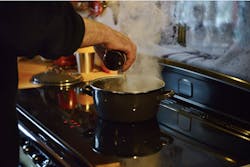Quality builders and remodelers provide energy-efficient homes that do a great job of keeping conditioned air in. But cooking, bathing, breathing and house cleaning introduce indoor pollutants, including additional moisture. New carpet and fresh paint give off chemicals used in their manufacture. Carbon monoxide (CO), humidity and mold, carbon dioxide (CO2), caustics, solvents and other volatile organic compounds (VOCs)—all of these can contribute to poor air quality.
Proper ventilation controls indoor air quality by diluting pollutants and removing them from the home. Infiltration—leakage of air through the building envelope from unintended gaps in walls, roofs, windows and doors—usually provides older homes with adequate though uncontrolled ventilation. However, improvements in construction and energy-efficient designs have resulted in today’s "tighter" buildings, which often require dedicated ventilation systems.
The Standards
ASHRAE 62-1989, Ventilation for Acceptable Indoor Air Quality, specifies a minimum of 0.35 air changes per hour (ACH) to maintain acceptable indoor conditions. One air change occurs when enough outdoor air moves through the house to replace the volume of the entire house one time. Studies show that infiltration rates generally range from 0.4 to 0.6 ACH for existing homes and 0.1 to 0.25 ACH for new homes.
Testing Ventilation Systems
PATH and partners Warren Builders and the NAHB Research Center recently cooperated on a field evaluation of three mechanical ventilation strategies. The site was a new single-story, 1,440-square-foot Warren Builders home in Albertville, Ala.
Three independent mechanical ventilation systems were installed in one house for a direct comparison of the systems and to evaluate the house with no ventilation.
- A central fan integrated (CFI) system, the most moderately priced system at $399 including installation, had an 8-inch duct that pulled outdoor air into the central heating and cooling system’s return-air plenum. The outdoor air was drawn into the plenum through a motorized damper controlled by cycling controls and distributed through the home’s central system.
- A multiport supply (MPS) system, the medium-priced system at $679, consisted of a Fantech FR100 fan installed in the attic, with 4-inch ducts supplying air to the living room and bedrooms. The system operated independent of the central HVAC system.
- A dehumidifying supply ventilator, a DEC Ultra-Aire, pulled outdoor air from an 8-inch duct and also drew return air from within the house. The two airstreams were mixed and filtered, dehumidified as necessary and distributed by the home’s central HVAC system. With its compressor and ports to mix inside and outside air, the DEC was the most expensive system at $2,015.
The house received 0.1 ACH with no mechanical ventilation. To comply with ASHRAE 62, all three mechanical systems were targeted to provide 0.35 ACH. To accomplish this in their respective test phases, the MPS operated continuously, the CFI operated at 40 minutes per hour, and the DEC operated at 21/2 hours every four hours.
Operating costs ranged from 22 to 52 cents per day of use, including the cost of the fan energy and the cost to condition the outside air introduced into the house. The MPS was the least expensive to operate but offered neither filtration nor dehumidification. The CFI, with the second-highest operating cost, offered filtration. The DEC was the most expensive to operate but provided filtration and dehumidification as required.
|
Daily Operating Costs for Ventilation Systems
|
||
|
Summer
|
Fall
|
|
|
Multiport supply
|
$0.29
|
$0.22
|
|
Dehumidifying supply
|
$0.48
|
$0.50
|
|
Central fan integrated
|
$0.32
|
$0.52
|
Performance of the Systems
While the homeowner found that all three systems provided a comfortable home - no drafts, stuffiness or signs of moisture - with consistent temperatures throughout, the builder clearly had a preference.
"It turned out the least expensive system we used seemed to do the best job and was really the easiest to install," Bret Warren says of the CFI system, which was left in the house at the end of the project.
"The DEC puts out so much heat as it dehumidifies. It makes a big load," he says. "We would have had to increase the size of the central unit."
For Warren, a former EnergyValue Housing Award winner who primarily builds tight, 1,200-square-foot homes for buyers who want low energy bills, the field evaluation was an important learning experience. "They brought out things I had never even thought about before," he says of the PATH team. Since the study, he has incorporated some of the low-cost air-sealing measures used in the project, including advanced framing techniques, in all his homes.
Choosing a Ventilation System
"Critical with any mechanical ventilation system is addressing the issue of when it’s going to operate and how it’s going to be controlled," says Andy Persily, a group leader in the Building Environment Division of the National Institute of Standards and Testing and past chair of ASHRAE 62.1, IAQ for Buildings.
When designing and in-stalling a system, the following factors come into play in defining the system’s operating time: the target air-exchange rate, the capacity of the ventilation fan, the power consumption of the ventilation fan, special needs within the house and the flexibility of ventilation controls.
To read more about this and other field studies of mechanical ventilation systems, visit PATH’s ToolBase Web site at toolbase.org.
Also, look for the new ASHRAE Standard 62.2, Ventilation and Acceptable Indoor Air Quality in Low-Rise Residential Buildings, the only nationally recognized indoor air quality standard developed solely for residences, according to committee chair Max Sherman. Applicable to new or existing houses, the standard offers modest-cost measures for improving IAQ, including guidance on selecting, installing and operating systems. Release is expected in early 2004.
